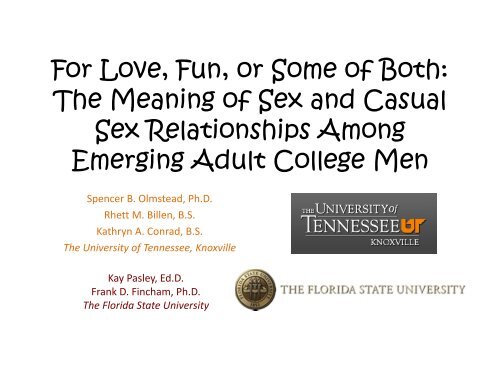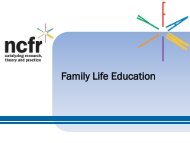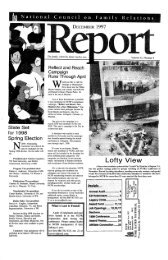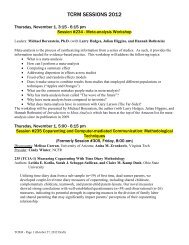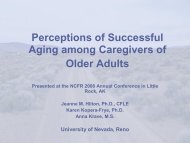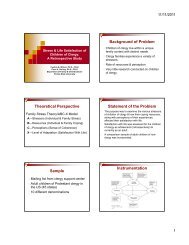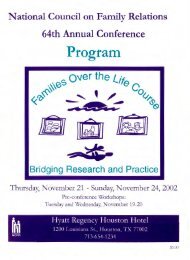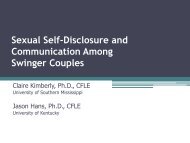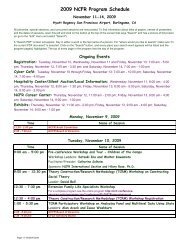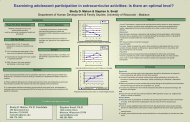For Love, Fun, or Some of Both: The Meaning of Sex and Casual ...
For Love, Fun, or Some of Both: The Meaning of Sex and Casual ...
For Love, Fun, or Some of Both: The Meaning of Sex and Casual ...
Create successful ePaper yourself
Turn your PDF publications into a flip-book with our unique Google optimized e-Paper software.
<strong>F<strong>or</strong></strong> <strong>Love</strong>, <strong>Fun</strong>, <strong>or</strong> <strong>Some</strong> <strong>of</strong> <strong>Both</strong>:<br />
<strong>The</strong> <strong>Meaning</strong> <strong>of</strong> <strong>Sex</strong> <strong>and</strong> <strong>Casual</strong><br />
<strong>Sex</strong> Relationships Among<br />
Emerging Adult College Men<br />
Spencer B. Olmstead, Ph.D.<br />
Rhett M. Billen, B.S.<br />
Kathryn A. Conrad, B.S.<br />
<strong>The</strong> University <strong>of</strong> Tennessee, Knoxville<br />
Kay Pasley, Ed.D.<br />
Frank D. Fincham, Ph.D.<br />
<strong>The</strong> Fl<strong>or</strong>ida State University
INTRODUCTION<br />
• Emerging Adulthood<br />
– A time <strong>of</strong> expl<strong>or</strong>ation <strong>and</strong> identity development 1<br />
– College campus provide opp<strong>or</strong>tunity f<strong>or</strong> romantic<br />
relationship <strong>and</strong> sexual expl<strong>or</strong>ation 2<br />
– <strong>Sex</strong>ual decision making imp<strong>or</strong>tant part <strong>of</strong><br />
navigating campus social life 3<br />
– A heterogeneous population 4
Romantic <strong>and</strong> <strong>Sex</strong>ual Relationships<br />
• Past research largely focused on sexual<br />
intimacy in committed relationships 5<br />
• Traditional dating scripts are largely outdated 2<br />
• Multiple pathways to sexual intimacy<br />
– Hookups<br />
– Friends with benefits relationships
<strong>Casual</strong> <strong>Sex</strong> Relationships<br />
Hooking Up<br />
• Common on college<br />
campuses 6<br />
• Partner can be a recent<br />
acquaintance, ex‐partner, <strong>or</strong><br />
friend 7,8<br />
• No expectations f<strong>or</strong><br />
commitment 6<br />
• Includes a variety <strong>of</strong><br />
intimate behavi<strong>or</strong>s 6<br />
Friends With Benefits<br />
• Less common than hookups 9<br />
• Ongoing intimate relationship 10<br />
• No expectations f<strong>or</strong><br />
commitment 9<br />
• May be guarded by rules <strong>and</strong><br />
guidelines 11<br />
• Partners typically do not<br />
classify the relationship as<br />
“romantic” 11<br />
• Includes a variety <strong>of</strong> intimate<br />
behavi<strong>or</strong>s 12
What Is Missing?<br />
• Most studies on casual sex relationships<br />
compare men <strong>and</strong> women<br />
• Limited underst<strong>and</strong>ing <strong>of</strong> emerging adults<br />
perceptions <strong>of</strong> the relationship between sex<br />
<strong>and</strong> commitment<br />
• Underst<strong>and</strong>ing about how men differ in their<br />
perceptions <strong>of</strong> sex <strong>and</strong> sexual behavi<strong>or</strong>s
Research Questions<br />
1. What is the meaning <strong>of</strong> sex (i.e., sexual<br />
activity, intercourse) f<strong>or</strong> emerging adult<br />
college men, <strong>and</strong> how do they see sex as<br />
related to commitment?<br />
2. How do men differ in their self‐rep<strong>or</strong>ted<br />
casual sex behavi<strong>or</strong>s based on the meanings<br />
<strong>of</strong> sex <strong>and</strong> its connection with commitment?
METHODS<br />
• Participants<br />
– 200 men enrolled in a family development course<br />
– Most were White (67.5%), heterosexual (93%),<br />
<strong>and</strong> underclassmen (36% freshmen, 34%<br />
sophom<strong>or</strong>es)<br />
– Average age was 19.3 (SD = 1.62)<br />
– Most rep<strong>or</strong>ted their parents as married <strong>and</strong> living<br />
together (68%) <strong>and</strong> not in a romantic relationship<br />
(60%)
METHODS<br />
• Procedures<br />
– Participants from a larger project on emerging<br />
adult romantic relationships<br />
– Completed online survey at three points during<br />
the semester<br />
– Completed a series <strong>of</strong> open‐ended questions<br />
about future committed romantic relationships as<br />
part <strong>of</strong> a course assignment<br />
– <strong>The</strong>se responses linked to survey data
Qualitative Content Analysis<br />
• <strong>F<strong>or</strong></strong> this study, we analyzed the following open‐ended<br />
questions:<br />
1. What does sex mean f<strong>or</strong> you?<br />
2. Is sex connected with commitment in a relationship <strong>and</strong><br />
why?<br />
3. Does one [sex <strong>or</strong> commitment] come bef<strong>or</strong>e the other?<br />
4. How does your expectation in this area affect your sex<br />
life?<br />
• Used grounded the<strong>or</strong>y methods (i.e., open, axial, <strong>and</strong><br />
selective coding) to analyze written responses to these<br />
items
Quantitative Measures<br />
• Demographic Characteristics<br />
– Race/ethnicity (1 = White, 0 = All others)<br />
– Year in school (1 = Underclassmen)<br />
– Romantic relationship status (1 = In a RR)<br />
– Family structure (1 = parents married <strong>and</strong> living together, 0 = All<br />
others)<br />
– Religious service attendance (0) Never <strong>or</strong> almost never to (3) one <strong>or</strong><br />
m<strong>or</strong>e times per week<br />
• Hookups<br />
– Rep<strong>or</strong>ted number <strong>of</strong> hookup partners in past 12 months (range = 0 to<br />
10 <strong>or</strong> m<strong>or</strong>e)<br />
• Friends With Benefits<br />
– Rep<strong>or</strong>ted number <strong>of</strong> FWB in past 12 months (range = 0 to 4 <strong>or</strong> m<strong>or</strong>e)
RESULTS<br />
• Qualitative Findings<br />
– Three groups emerged from the data:<br />
• <strong>The</strong> Committers (47%)<br />
• <strong>The</strong> Opp<strong>or</strong>tunists (41%)<br />
• <strong>The</strong> Recreationers (12%)
<strong>The</strong> Committers (47%)<br />
• Describe sex as behavi<strong>or</strong>s that exemplified<br />
connection in a relationship, a means <strong>of</strong> expressing<br />
love to one’s partner, <strong>and</strong> <strong>of</strong>ten as a demonstration<br />
<strong>of</strong> commitment<br />
• Consistently stated that sex <strong>and</strong> commitment were<br />
linked, <strong>and</strong> that commitment comes pri<strong>or</strong> to sex<br />
• Of all groups, this one most frequently described<br />
how the meaning they ascribed to sex affected their<br />
sexual behavi<strong>or</strong>s
<strong>The</strong> Opp<strong>or</strong>tunists (41%)<br />
• Identified dual meanings f<strong>or</strong> sex<br />
– <strong>Sex</strong> as an expression <strong>of</strong> love, compassion, <strong>and</strong> a<br />
representation <strong>of</strong> an intimate bond<br />
– <strong>Sex</strong> as meaningless, a means to satisfy sexual<br />
urges, a way to get one’s “mind <strong>of</strong>f <strong>of</strong> things”, <strong>and</strong><br />
having “a good time”<br />
• <strong>Sex</strong> <strong>and</strong> commitment could be related<br />
• Could not readily identify how such ascribed<br />
meaning affected sexual behavi<strong>or</strong>s
<strong>The</strong> Recreationers (12%)<br />
• <strong>Sex</strong> did not hold a meaning<br />
– It is primarily f<strong>or</strong> entertainment purposes<br />
• <strong>Sex</strong> <strong>and</strong> commitment not connected<br />
– Especially at this stage in the life course<br />
• <strong>The</strong>ir self ascribed meaning had little bearing<br />
on actual sexual behavi<strong>or</strong>
RESULTS<br />
• Quantitative Findings<br />
• Ran a series <strong>of</strong> chi‐square analyses <strong>and</strong> ANOVAs<br />
• Demographic Items<br />
– M<strong>or</strong>e White men were committers, m<strong>or</strong>e min<strong>or</strong>ity<br />
men were opp<strong>or</strong>tunists<br />
– Committers attended religious services m<strong>or</strong>e<br />
frequently than did Opp<strong>or</strong>tunists<br />
– No differences on year in school, romantic<br />
relationship status, <strong>or</strong> family structure
<strong>Casual</strong> <strong>Sex</strong> Relationships<br />
• Hookups<br />
– Committers (M=1.97, SD=2.8) had fewer hookup<br />
partners in the past 12 months than Opp<strong>or</strong>tunists<br />
(M=4.51, SD=3.61) <strong>and</strong> Recreationers (M=4.43,<br />
SD=3.63) groups (p≤.001, p=.01)<br />
– No differences between Opp<strong>or</strong>tunists <strong>and</strong><br />
Recreationers groups
<strong>Casual</strong> <strong>Sex</strong> Relationships<br />
• Friends With Benefits<br />
– Committers (M=.40, SD=.79) had fewer FWBR<br />
partners in the past 12 months than Opp<strong>or</strong>tunists<br />
(M=1.42, SD=1.34) <strong>and</strong> Recreationers (M=1.73,<br />
SD=1.61) groups (p≤.001, p=.003)<br />
– No differences between Opp<strong>or</strong>tunists <strong>and</strong><br />
Recreationers groups
DISCUSSION<br />
• Men differ in imp<strong>or</strong>tant ways regarding their<br />
expectations <strong>and</strong> perceptions <strong>of</strong> the<br />
relationship between sex <strong>and</strong> commitment<br />
• <strong>The</strong>se perceptions were largely supp<strong>or</strong>ted by<br />
self‐rep<strong>or</strong>ts <strong>of</strong> casual sex behavi<strong>or</strong><br />
• Our largest group <strong>of</strong> men does not fit with<br />
stereotypical conceptions <strong>of</strong> the college male
Limitations <strong>and</strong> Implications<br />
• Convenience sample <strong>of</strong><br />
college men<br />
• Did not engage in<br />
“member checking”<br />
• “<strong>Sex</strong>” <strong>and</strong><br />
“commitment” were<br />
not defined<br />
• Social desirability bias<br />
• Parent education<br />
– Parents play an imp<strong>or</strong>tant role in<br />
socializing children about<br />
conceptions <strong>of</strong> sex<br />
• Relationship education<br />
– Promote safer sex practices <strong>and</strong><br />
intentional relationship decision<br />
making among EAs<br />
• Research<br />
– Continue to expl<strong>or</strong>e variations in<br />
college men’s sexual behavi<strong>or</strong>s
REFERENCES<br />
1. Arnett, J. J. (2004). Emerging adulthood: <strong>The</strong> winding road from the late teens through the early twenties. New Y<strong>or</strong>k:<br />
Oxf<strong>or</strong>d University Press.<br />
2. Bogle, K. A. (2008). Hooking up: <strong>Sex</strong>, dating, <strong>and</strong> relationships on campus. New Y<strong>or</strong>k: New Y<strong>or</strong>k University Press.<br />
3. Allen, K. R., Husser, E. K., Stone, D. J., & J<strong>or</strong>dal, C. E. (2008). Agency <strong>and</strong> err<strong>or</strong> in young adults’ st<strong>or</strong>ies <strong>of</strong> sexual decision<br />
making. Family Relations, 57, 517‐529.<br />
4. Arnett, J. J. (2006). Emerging adulthood: Underst<strong>and</strong>ing the new way <strong>of</strong> coming <strong>of</strong> age. In J. J. Arnett & J. L. Tanner (Eds.),<br />
Emerging adults in America: Coming <strong>of</strong> age in the 21 st century (pp. 3‐19). Washington, DC: American Psychological<br />
Association.<br />
5. M<strong>or</strong>r Serewicz, M. C. M., & Gale, E. (2008). First date scripts: Gender roles, context, <strong>and</strong> relationship. <strong>Sex</strong> Roles, 58, 149‐<br />
164.<br />
6. Owen, J., Rhoades, G. K., Stanley, S. M., & Fincham, F. D. (2010). “Hooking up” among college students: Demographic <strong>and</strong><br />
psychosocial c<strong>or</strong>relates. Archives <strong>of</strong> <strong>Sex</strong>ual Behavi<strong>or</strong>, 39, 653‐663.<br />
7. Gute, G., & Eshbaugh, E. M (2008). Personality as a predict<strong>or</strong> <strong>of</strong> hooking up among college students. Journal <strong>of</strong><br />
Community Health Nursing, 25, 26‐43.<br />
8. Fielder, R. L., & Carey, M. P. (2010). Prevalence <strong>and</strong> characteristics <strong>of</strong> sexual hookups among first‐semester female college<br />
students. Journal <strong>of</strong> <strong>Sex</strong> & Marital <strong>The</strong>rapy, 36, 346‐359.<br />
9. Lehmiller, J. J., V<strong>and</strong>erDrift, L. E., & Kelly, J. R. (2011). <strong>Sex</strong> differences in approaching friends with benefits relationships.<br />
<strong>The</strong> Journal <strong>of</strong> <strong>Sex</strong> Research, 48, 275‐284.<br />
10. Epstein, M., Calzo, J. P., Smiler, A. P., & Ward, L. M. (2009). “Anything from making out to having sex”: Men’s negotiation<br />
<strong>of</strong> hooking up <strong>and</strong> friends with benefits scripts. <strong>The</strong> Journal <strong>of</strong> <strong>Sex</strong> Research, 46, 414‐424.<br />
11. Hughes, M., M<strong>or</strong>rison, K., & Asada, K. K. (2005). What’s love got to do with it? Expl<strong>or</strong>ing the impact <strong>of</strong> maintenance rules,<br />
love attitudes, <strong>and</strong> netw<strong>or</strong>k supp<strong>or</strong>t on friends with benefits relationships. Western Journal <strong>of</strong> Communication, 69, 49‐66.<br />
12. Bisson, M. A., & Levine, T. R. (2009). Negotiating a friends with benefits relationship. Archives <strong>of</strong> <strong>Sex</strong>ual Behavi<strong>or</strong>, 38, 66‐<br />
73.


